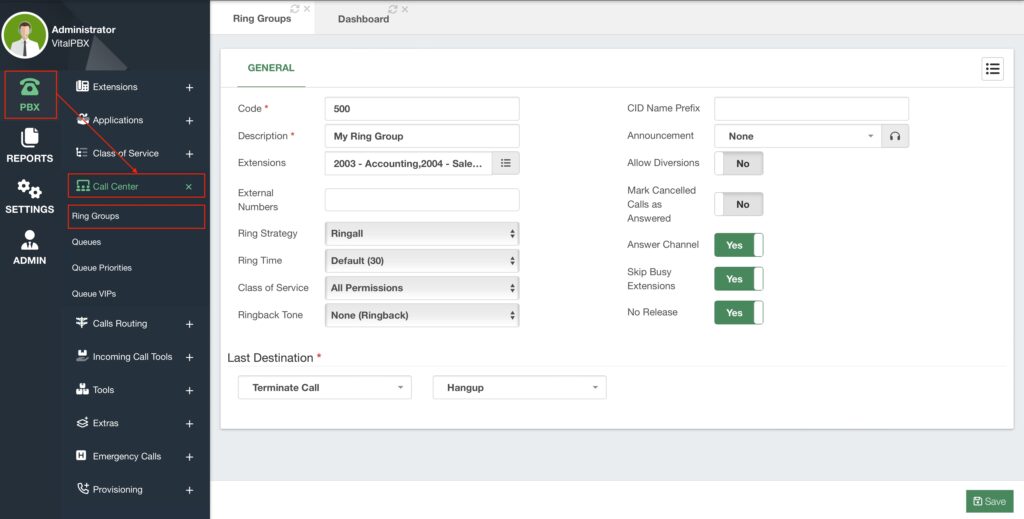As mentioned in the previous lesson, there are two ways you can distribute calls to a group of people. This can be with a Queue or a Ring Group. The most simple of these is the Ring Group. With Ring Groups you can easily call multiple extensions at once. To start creating our ring group, we must go to PBX > Call Center > Ring Groups.

The first thing you will enter is a Code for the ring group. This is the number you will need to dial to reach this ring group. Then, add a Description so we can identify the ring group.
Afterward, we must include the Extensions that belong to the ring group. These are the extensions that will be called when calling the ring group.
Optionally, members of this ring group can also be an External Number. Keep in mind, when using external numbers, you need to choose an appropriate Class of Service so the module can reach the external number.
Next, choose the Ring Strategy that best fits your needs, be it Ring All or One by one.
There are a couple of options that can help the members of a ring group to identify incoming calls. CID Name Prefix will add anything you enter in this field to the caller’s Caller ID Name. This way, you get to see that the call is from this ring group. You can also add an Announcement, which will playback to the ring group member before connecting the incoming call.
Lastly, let’s add a Last Destination, which is the destination for the call when the Ring Time runs out and none of the members answers the call. With this, you can Save and Apply Changes.
Some additional configurations you can perform in this module are as follows.
- Ringback Tone – This is a Music on Hold class to playback while someone is calling
the ring group. - Allow Diversions – With this feature enabled, the ring group members can enable any
call diversions, i.e. call forwards, which will affect the incoming calls to the ring group. - Mark Cancelled Calls as Answered – This will mark the calls as Answered if one of
the ring group members answers the calls. With this disabled, calls will appear as
missed in the extensions for the members who did not answer the call. - Answer Channel – This is the default behavior for a ring group, as the ring group
module will answer the call, and then connect it with any member that answers their
phone. With this feature turned off, calls will not be marked as answered until a
member answers the call. Keep in mind, that if you turn it off, audio (i.e. Music on
Hold) may not playback, as the call is still ringing the system. - Skip Busy Extensions – If this is turned on, any extension with a busy status will be
skipped. - No Release – This adds the no-release (/n) flag to the ring group members. This
avoids creating multiple items in the CDR. Nevertheless, some phones may present
issues on transfers when this feature is enabled, therefore it can be disabled.
And with this, you now have a Ring Group created. You can dial the ring group code from any device that does not belong to the ring group and members will start to ring. As you can see this is a very straightforward module that easily allows you to dial multiple extensions.




